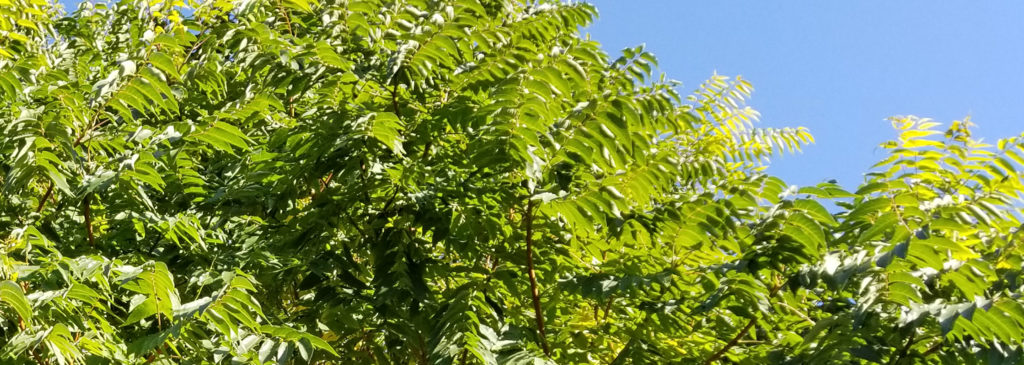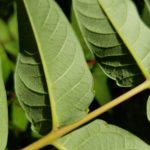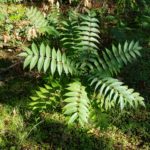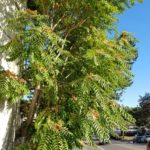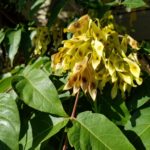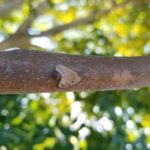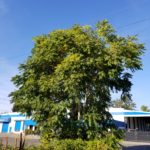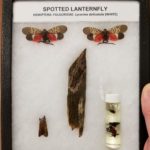Common name:
tree-of-heaven, stinking sumac, stinking quassia, copal-tree, Chinese sumac, varnish tree
Scientific Name:
Ailanthus altissima
Noxious Weed Listing:
- WeedWise: Maintenance
- State of Oregon: Class B
- State of Washington: Class C
- Four County CWMA: Class B
- Columbia Gorge CWMA: Class C
Description:
General:
Tree-of-heaven is an introduced deciduous tree species that can grow up to 80 feet tall and six feet in diameter. It has large pinnately compound leaves. Plants are dioecious (male or female) with females producing copious seeds each season.
It is seen in diverse locations across our region but is most commonly seen growing in urban areas, where it was once intentionally introduced. Vast numbers of seedlings, saplings, and suckering plants can be seen growing near larger parent trees. The bark on young trees is smooth and green. As it ages, the bark turns gray and develops shallow, diamond-shaped fissures. The green to brown branches grow alternately on the tree and have a pithy, brown center. The branches are also pock-marked with a V-shaped or heart-shaped leaf scars.
Leaves:
Leaves are pinnately compound, meaning they have leaflets attached on each side of a central stem. Leaflets have mostly smooth edges with one to two protruding bumps at the base called glandular teeth. When crushed, the leaves can have a rancid peanut butter-like odor.
Flowers
Male and female flowers form in terminal clusters on separate trees. Flower clusters may be up to 12 inches wide and are largest on male trees. Tiny individual flowers are light green to pale.
Fruits
In late summer through autumn, tree-of-heaven produces large clusters of papery winged fruit known as samaras. Each fruit contains a single central seed. The samaras vary from greenish-yellow to red-brown and are often vibrantly colored in the fall.
Roots
Tree-of-heaven produces a long taproot and suckers freely when cut, making it difficult to control. Creeping roots may extend outward up to 50 feet in all directions.
Look-a-likes
Tree-of-heaven can be easily confused with other trees that have compound leaves with many leaflets, such as sumac or walnut. The leaf edges of the look-alikes typically have teeth or serrations, while those of tree-of-heaven are smooth. Tree-of-heaven has characteristic glandular teeth and the base of the leaves which help to distinguish it from look-a-likes.
Reproduction:
This weed reproduces both by seed and vegetatively through sprouting roots. New shoots can sprout as far as 50 feet away from the parent tree. One tree can produce over 300,000 seeds annually, which are then dispersed by water, wind, and birds. Cut stems can form roots when left on moist ground.
Habitat:
Tree-of-heaven grows in a variety of habitats and is commonly found in disturbed areas along forest edges, roadsides, fence rows, urban parks, old fields, and railroad embankments. It is tolerant of full sun to part shade, many types of pollution, and poor soil conditions. It can grow in many harsh environments, including pavement cracks and building foundations!
Impacts:
- Due to its rapid growth and structural weakness, tree-of-heaven is considered a fall hazard. Its roots damage pavement, roads, and building foundations in urban areas.
- Tree-of-heaven produces allelopathic chemicals in its leaves, roots, and bark. These are chemicals that adversely affect the germination, growth, survival, and reproduction of other plants.
- These trees can form dense thickets which reduce wildlife habitat, particularly in riparian areas.
- It is a favorite host for the spotted lanternfly, an invasive and agriculturally damaging pest. (NOTE: If you find a spotted lanternfly on your property, please report it immediately).
- Tree-of-heaven can also be toxic. See caution information below.
Caution:
Tree of heaven has been known to cause skin irritations or allergies in some people. Additionally, there have been rare reports of myocarditis (inflammation of the heart muscle) from exposure to sap through broken skin. People who work around the tree should wear personal protective equipment, including eyewear and gloves.
Introduction:
The first documented appearance of tree-of-heaven in Oregon can be found in local herbaria dating back in 1904, in Wasco County. The plant is native to China and was commonly introduced as an ornamental plant before escaping cultivation. It is believed to have been introduced sometime between 1875 and 1899.
Distribution:
Clackamas County:
Tree-of-heaven is found throughout much of Clackamas County. As a common weed, this is not a species that is actively surveyed. The mapped distributions do not represent the full extent of tree-of-heaven in Clackamas County.
State of Oregon:
United States:
Management:
Strategy:
The management of invasive weeds is best served through a process known as Integrated Pest Management (IPM). IPM is a weed management methodology that utilizes:
- Management thresholds to determine when and if to initiate control,
- The ecology and life history characteristics of the targeted invasive weed,
- Site-specific conditions and land use considerations to inform management practices,
- The effectiveness and efficiency of various control methods.
An IPM based strategy ensures the maximum effectiveness of treatment measures. IPM strategies typically use more than one management method to target one or more susceptible life stages. It is adaptive to site conditions in the field and to the response of a plant to management. The utilization of multiple management tools also inherently reduces the use of herbicides in a management plan. The IPM process ultimately provides a framework for the establishment of Best Management Practices (BMP) which outlines the best approach for controlling a weed particular infestation.
Planning Considerations
- Survey area for weeds, set priorities and select the best control method(s) for the site.
- Control practices should be selected to minimize soil disturbance. Minimizing soil disturbances reduces erosion and avoids creating more opportunities for weed seed germination.
- Begin work on the perimeter of the infested areas first and move inward toward the core of the infestation.
- Monitor the site and continue to treat plants that germinate from the seed bank.
- Re-vegetate treatment areas to improve ecosystem function and prevent new infestations.
Manual:
Manual removal of tree-of-heaven can be an effective control option for seedlings and small samplings, but it is labor-intensive. Plants can be pulled when the soil is moist to ease the removal of the roots and to put less strain on the worker. All plants and roots need to be removed to prevent regrowth. A weed wrench, shovel, or hoe can be used to assist with root removal. Sites should be monitored for regrowth regularly to ensure complete control. Once plants become too large and develop a strong root system other control methods will be required.
While manual removal can be an effective treatment, it can cause heavy soil disturbances on site. Soil disturbance can bring tree-of-heaven seeds to the surface creating a new generation of growth. Minimize soil disturbance and re-vegetate disturbed areas to prevent further infestations.
Cutting tree-of-heaven is not effective and should be avoided. Cutting can stimulate the suckering of new shoots, especially in larger specimens. A hack-and-squirt, or similar herbicide treatment (see below) will need to be utilized to control suckering and continued growth following cutting.
Mechanical:
The cutting of a large tree-of-heaven is ineffective on its own. Cut trees will lead to significant resprouting from roots. As a result, cutting and removal of well-established trees should only be incorporated after trees have received a prescribed herbicide treatment. Chain saws are typically used to fell dead or dying tree-of-heaven following herbicide treatments. Large specimens can pose a risk to people and property. Whenever you are working in sensitive areas, you should coordinate removal activities with a licensed arborist.
Cultural:
Tree-of-heaven does not compete well in heavily shaded areas. Competitive plantings can help to minimize the impacts of tree-of-heave and prevent establishment.
Chemical:
Chemical control is an effective tool to control large trees and dense infestations. Tree-of-heaven is susceptible to several systemic herbicides. Plants should be treated using foliar treatments, basal bark, hack, and squirt, or cut stump methods. Chemical control options are frequently used in conjunction with other control practices within a broader IPM framework.
Before you Start:
- Before purchasing any herbicide product it is important to read the label. The label is the Law. Carefully review all parts of the label even if you have used the product before. Select a product that is most appropriate for your site. If you have questions, ask your vendor before purchasing a product.
- When selecting herbicides always use a product appropriately labeled for your site. Follow label recommendations and restrictions at all times. If any information provided here contradicts the label, the label takes precedence. Always follow the label!
- Protect yourself. Always wear the recommended protective clothing identified on your label and shower after use.
- When applying herbicides use spot spray techniques whenever possible to avoid harming non-target plants.
- Do not apply during windy or breezy conditions that may result in drift to non-target plants
- Avoid spraying near water. Hand-pull in these areas, when possible to protect aquatic and riparian plants and wildlife.
- Avoid exposure to pets, pollinators, and wildlife. Remove animals from treatment areas to avoid exposure to herbicides. Follow the reentry instructions on your herbicide label and keep pets out of the area until the herbicides have dried. Avoid spraying when insects and animals are active. Avoid spraying blooming plants to minimize any effects to bees and pollinators.
- Be sure to store any chemicals, out of the reach of children and pets to keep your family safe.
- Product labels and formulations change regularly. Check the Pacific Northwest Weed Management Handbook and the label for current control recommendations.
Herbicides:
The mention of any brand name product is not, and should not be construed as an endorsement for that product. They are included here only for educational purposes. Suggested rates are generalized by active ingredients. Specific rates will vary between products. Be sure to review the label before application and use the recommended label rate at all times.
Active Ingredients
Product Names: Accord, Aquamaster, Rodeo, Roundup, and various others (glyphosate) + Garlon 3a, Element 3a, Vastlan (Triclopyr)
Rate:
Foliar treat: use glyphosate at 3 qts/acre with triclopyr at 1.5 – 2qts/ac, plus a non-ionic surfactant.
Time: Foliar applications should be carried out in summer or early fall.
Comments: Re-treatment may be required to achieve effective control. This mixture is not selective and will harm grasses and other desirable vegetation. Use care when working around desirable plants to avoid damage. Leaves should be sprayed until wet but not dripping to achieve good control.
Product Names: Accord, Aquamaster, Rodeo, Roundup, XRT II, and various others
Rate:
Foliar treat: use 2.0% to 4.0% v/v solutions, plus 0.5% v/v non-ionic surfactant.
Hack and Squirt: apply 1 cut for every 3 inches of stem diameter, and apply 1 ml of undiluted herbicide to each cut.
Time: Foliar application and Hack and squirt treatments should be carried out in summer or early fall.
Comments: Re-treatment may be required to achieve effective control. Glyphosate is not selective and will harm grasses and other desirable vegetation. Use care when working around desirable plants to avoid damage. Leaves should be sprayed until wet but not dripping to achieve good control. Cut stems horizontally at or near ground level and immediately apply herbicide.
Product Names: Garlon 4 (triclopyr ester), Garlon 3A, Element 3A (triclopyr amine), Pathfinder II, Vastlan
Rate:
Foliar treat: 1.0% to 2.0% v/v solution, plus 0.5% v/v non-ionic surfactant.
Hack and Squirt: make 1 cut for every 3 inches of stem diameter, and apply 1 ml of undiluted herbicide to each cut.
Basal Bark: use 20%-30% v/v in 70%-80% oil carrier.
Cut Stump: use 20%-25% v/v solution.
Time: Foliar application and Hack and squirt treatments should be carried out in summer or early fall.
Comments: Re-treatment may be required to achieve effective control. Triclopyr is selective and will not harm grasses but will harm desirable broadleaf plants, trees, and shrubs. Use care when working around desirable plants to avoid damage. Leaves should be sprayed until wet but not dripping to achieve good control. Triclopyr ester formulations may volatilize under warm temperatures. Expect root suckering following cut stump treatments.
Product Names: Vanquish, Banvel
Rate:
Foliar treat:5.0% v/v solution, plus 0.5% v/v non-ionic surfactant.
Cut Stump: use 25%-50% v/v solution.
Time: Foliar application and cut stump treatments should be carried out in summer or early fall.
Comments: Re-treatment may be required to achieve effective control. Dicamba is selective and will not harm grasses but will harm desirable broadleaf plants, trees, and shrubs. Use care when working around desirable plants to avoid damage. Leaves should be sprayed until wet but not dripping to achieve good control. Dicamba formulations volatilize under warm temperatures. Expect root suckering following cut stump treatments.
Product Names: Capstone
Rate:
Foliar treat: 1.0% to 1.5% v/v solution, plus 0.5% v/v non-ionic surfactant.
Time: Foliar application treatments should be carried out in summer or early fall.
Comments: Re-treatment may be required to achieve effective control. Triclopyr + aminopyralid is selective and will not harm grasses but will harm desirable broadleaf plants, trees, and shrubs. Use care when working around desirable plants to avoid damage. Leaves should be sprayed until wet but not dripping to achieve good control. Formulations may volatilize under warm temperatures.
Product Names: Arsenal, Habitat, Stalker, Chopper, Polaris
Rate:
Foliar treat: 1 to 2% v/v solution plus 0.25 to 0.5% surfactant v/v
Cut stump: 20% v/v solution in water plus 80% oil or water carrier, depending on product used.
Hack and Squirt: make 1 cut for every 3 inches of stem diameter, and apply 1 ml of undiluted herbicide to each cut.
Basal Bark: use 20% in 80% oil carrier.
Time: Foliar application and Hack and squirt treatments should be carried out in summer or early fall.
Comments: Imazapyr is a soil residual herbicide and may result in bare ground around plants after treatment.
Product Names: Escort
Rate:
Foliar treat: 2 oz per acre
Time: Foliar application treatments should be carried out in summer or early fall.
Comments: Can be tank-mixed with glyphosate or triclopyr
Biological:
There are no approved biological agents available at this time. Current research is underway to determine the suitability of three fungal pathogens and two insects to help control tree-of-heaven.
Disposal:
Small tree-of-heaven plants that have not gone to seed can be disposed of in yard debris containers. Tree-of-heaven plants that have gone to seed should be kept on-site to minimize the spread of the seeds, or bagged before disposal. Larger trees should be chipped or left on-site following removal, when possible. In some areas plant debris can be burned on-site with appropriate safety measures and permits. You should check with your local Fire District or the Oregon Department of Forestry for rules and recommendations.
Follow-Up:
Diligence is the most important aspect of controlling tree-of-heaven. Removal of new tree-of-heaven plants and monitoring and retreatment of suckering roots may occur years following treatment. So follow-up is required. Work with neighbors to target nearby seeding trees.
Best Management Practices:
Small Infestations:
- Consider the land use practices on site. Identify, any site-specific considerations that should be taken into account before initiating control.
- Be sure you can properly identify tree-of-heaven. If you are unsure about identification contact the WeedWise program for help with identification.
- Identify any native or desirable plants nearby, and take precautions to minimize any negative impact on them.
- Manual removal is very effective at controlling small tree-of-heaven plants. Plants can be pulled using a weed wrench or dug up when the soil is moist.
- Replace divots and holes created.
- Use prescribed herbicides, when plants are too large to be removed.
- Monitor the site for regrowth, and remove or spray new sprouts as they emerge.
- Do not leave soil bare. Mulch to stabilize the soil during control activities.
- Replant heavily infested areas to increase shade and compete with tree-of-heaven regrowth.
Large Infestations:
- Consider the land use practices on site. Identify, any site-specific considerations that should be taken into account before initiating control.
- Be sure you can properly identify tree-of-heaven. If you are unsure about identification contact the WeedWise program for help with identification.
- Identify any native or desirable plants nearby, and take precautions to minimize any negative impact on them.
- Treat smaller saplings using a foliar application of herbicides or basal bark application.
- Treat larger trees using a hack and squirt method to kill the tree prior to removal. Once large trees have died, cut and remove standing trees.
- Several applications may be required to suppress and eradicate large tree-of-heaven infestations.
- Monitor the site for regrowth. Broadcast or spot treat seedlings, resprouting plants, and suckering roots.
- Do not leave soil bare. Mulch to stabilize the soil during control activities.
- Replant heavily infested areas to increase shade and compete with tree-of-heaven regrowth.
Fun Facts:
- Tree-of-heaven was first introduced to the United States in 1784 by a gardener in Philadelphia, PA.
- Tree-of-heaven can grow 3-5 ft per year.
- In traditional folk medicine tree-of-heaven has been used to treat diarrhea, asthma, cramps, epilepsy, fast heart rate, and gonorrhea.
- Tree-of-heaven is one of the most pollution tolerant trees species
Gallery:
- The underside of tree-of-heaven leaves with glands. Photo: Samuel Leininger, Clackamas SWCD
- Tree-of-heaven sampling. Photo: Samuel Leininger, Clackamas SWCD
- Large Tree-of-heaven. Photo: Samuel Leininger, Clackamas SWCD
- Tree-of-heaven growing into the foundation of a building. Photo: Samuel Leininger, Clackamas SWCD
- Female tree-of-heaven with fruits. Photo: Samuel Leininger, Clackamas SWCD
- Tree-of-heaven fruits. Photo: Samuel Leininger, Clackamas SWCD
- Heart-shaped leaf scar. Photo: Samuel Leininger, Clackamas SWCD
- Tree-of-heaven leaf coloration. Photo: Samuel Leininger, Clackamas SWCD
- Mature tree-of-heaven. Photo: Samuel Leininger, Clackamas SWCD
- Tree-of-heaven coupound leaf. Photo: Samuel Leininger, Clackamas SWCD
- Tree of Heaven Flower Cluster. Photo by: Leslie J. Mehrhoff, University of Connecticut, Bugwood.org
- Spotted lanternfly in various stages of development. Photo: Samuel Leininger, Clackamas SWCD
Additional Information:
- Columbia Gorge CWMA- Tree-of-heaven Best Management Practices
- Oregon Department of Agriculture: Tree-of-heaven
- Washington State Noxious Weed Control Board; Tree-of-Heaven
- Penn State Extension: Tree-of-Heaven
- Invasive.org: GIST Elemental Stewardship Abstract
- Weeds in Natural Areas: Tree of Heaven
- Center for Invasive Species and Ecosystem Health
- CABI Global Invasive Species Compendium
References:
- Christy, J. A., A. Kimpo, V. Marttala, P. K. Gaddis, & N. L. Christy. 2009. Urbanizing Flora of Portland Oregon 1806-2008. Native Plant Society of Oregon Occasional Paper 3 pg. 241.
- Columbia Gorge Cooperative Weed Management Area. 2019. Tree-of-heaven Best Management Practices. http://columbiagorgecwma.org/weed-listing/best-management-practices/tree-of-heaven. (Retrieved Oct 11, 2021)
- Consortium of Pacific Northwest Herbaria Specimen Database (CPNWH). 2021. https://www.pnwherbaria.org (Retrieved October 12, 2021).
- DiTomaso, J.M. & E.A. Healy. 2007. Weeds of California and Other Western State vol 2. University of California ANR. pp 1499-1502.
- DiTomaso, J.M., G.B. Kyser, S.R. Oneto, R. G. Wilson, S. B. Orloff, L. W. Anderson, S. D. Wright, J.A. Roncoroni, T.L. Miller, T.S. Prather. 2013. Weed Control in Natural Areas in the Western United States. Davis, CA: UC Weed Research and Information Center. pp 23-24.
- Jackson, D.R, A. Gover, S. Wurzbacher. 2020. Invasive Plant Fact Sheet, Tree-of-Heaven Ailanthus altissima. https://extension.psu.edu/downloadable/download/sample/sample_id/2661/ (Retrieved Oct 11, 2021). Penn State University.
- Oregon Flora Project. 2021. Oregon Plant Atlas: AIlanthus altissima. https://oregonflora.org/spatial/index.php .(Retrieved October 11, 2021)
- USDA, Forest Service, Southwestern Region. 2014. Field Guide for Managing Tree-of-heaven in the Southwest. https://www.fs.usda.gov/Internet/FSE_DOCUMENTS/fseprd563049.pdf (Retrieved Oct 11, 2021).
- USDA, NRCS. 2021. The PLANTS Database http://plants.usda.gov (Retrieved Oct 11, 2021). National Plant Data Team, Greensboro, NC USA.

